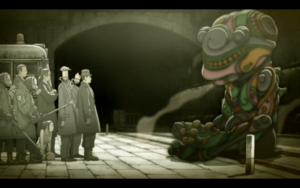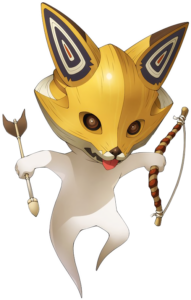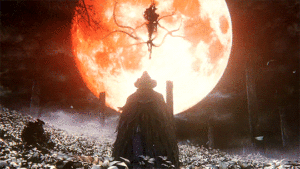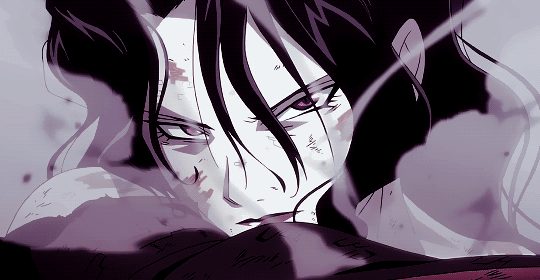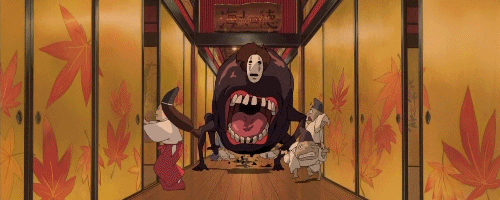I have been thinking about two wildly different shows: Mrs. Davis (a stage magician hunting nun / mystic from Reno, Nevada) and Scavengers Reign (space colonists get marooned on a planet with a mysterious and infinitely complex ecology).
What they have in common is a strong sense that something strange is going on deep behind the scenes. This often manifests as a snowballing series of semirelated or ambiguously related encounters. Sister Simone in Mrs. Davis keeps on running to a number of feuding secret societies and their agents who have an intense but unknown interest in her and each other. When you have a run in with the superintelligent AI app, the weird German treasure hunters take notice, which leads to an encounter with yet another faction when they intervene in ways I don’t want to spoil.
Similarly, the survivors in Scavengers Reign stumble across a creature that’s hunting or being hunting, which then kicks off a long series of encounters as predators and prey get involved and entangle/endanger the survivors further.
I’ve modeled how this could work in games in a short encounter table. Basically, you have encounters as normal, but certain reaction roll results either guarantee a certain encounter the next turn or guarantee that the next rolled encounter will be with a certain creature. If you run into a stressed out and Unfriendly prey animal, it means there’s a predator nearby. This means you can have normal encounters, but some make you fall forward into another encounter that demonstrates the relationships between creatures. There’s a little extra bookkeeping, but you just have to make note of what happens next turn and what replaces the next encounter, which isn’t too complex.
1d4 Indigo Steppe Encounter Table
- 2d100 Carrot Snails
- 3d6 Humpbacked Oryxes
- 1 Langouste Leopard
- 2d4 Big Scarlet Crawler
Carrot Snail
| Roll | Result |
|---|---|
| 2 | Highly stressed by a nearby predator; will vent harmless but foul-smelling oil out of their eyespots on anyone who enters melee range. Next turn is a guaranteed encounter of humpbacked oryxes in addition to rolled results. Next rolled encounter is replaced with langouste leopards, attracted by the scent of snail oil that humpbacked oryxes are often drenched in. |
| 3-5 | Being hunted. Next rolled encounter result is replaced with humpbacked oryxes that are on the snails’ trail |
| 6-9 | Photosynthesizing, unbothered. |
| 10-11 | Senescent. These snails are at the end of their lifespan and full of seed-larva. They offer themselves up to likely predators in hope they will be eaten, thus spreading their larva (which gestate as they pass harmlessly through the eater’s digestive tract). |
| 12 | Will warble and approach with adorable little hops. They are infected with megaplasmodia; their eyespots will erupt into plumes of bacteria-bearing aerosol upon entering melee range of any uninfected creature. Save vs Poison get infected with megaplasmodia. |
3d6 Humpbacked Oryx
| Roll | Result |
|---|---|
| 2 | Moving quickly because a langouste leopard is in the area. Next encounter is replaced with a langouste leopard. |
| 3-5 | Protecting their young. 2d6 oryx calves are hidden nearby; the adult oryxes will go berserk if they are approached. |
| 6-9 | Grazing. Next rolled encounter is replaced with big scarlet crawlers that want to scavenge their shit. |
| 10-11 | Hungry, scavenging. Will nose through pockets and bags looking for food and positively remember anyone who gives them something. |
| 12 | Will amble up amicably. They are infected with megaplasmodia; their eyes will explode into plumes of bacteria-bearing aerosol upon entering melee range of any uninfected creature. Save vs Poison get infected with megaplasmodia. |
1 Langouste Leopard
| Roll | Result |
|---|---|
| 2 | Starved, sick. Can’t fail morale checks. |
| 3-5 | Hunting. Will attack but retreat if faced with any real violence. Until killed or fully chased off, it will secretly accompany every subsequent encounter, waiting for a chance to ambush. |
| 6-9 | Hunting something else. |
| 10-11 | Just ate; curious. Will accept bribes and is less likely to hunt anyone who bribes it with snacks. |
| 12 | Will act like a big cute cat. It is infected with megaplasmodia; after frolicking for a little while, it will turn to leave just as its tail explodes into a giant plume of bacteria-bearing aerosol. Save vs Poison get infected with megaplasmodia. |
2d4 Big Scarlet Crawlers
| Roll | Result |
|---|---|
| 2 | Confused. They are infected with megaplasmodia and will detonate into a sticky spume of bacteria-bearing purple ichor as soon as they ram into an uninfected creature. Take 3d6 damage, Save vs Breath for half; Save vs Poison or get infected with megaplasmodia. |
| 3-5 | Performing a mating ritual. Will attack only if approached. |
| 6-9 | Busily sifting through piles of oryx dung. |
| 10-11 | By chance unthreatened by the PCs; if offered food, they will trail behind by them until the next time the party rests, effacing all trace of their passage; negates all impending encounters. If there are no impending encounters, players can choose to reroll the encounter die the next time an encounter is rolled. |
| 12 | Will trail the PCs, effacing all trace of their passage; negates all impending encounters. If there are no impending encounters, players can choose to reroll the encounter die the next time an encounter is rolled. |
Uses
This is probably best for relatively small encounter tables in places that PCs will be spending a lot of time in; if they’re just passing through or there are a lot of different kinds of encounters, I think it could end up as just a bunch of weird stuff happening. PCs have to linger long enough to understand how different behaviors are associated with different outcomes for the interesting part of this mechanic to really kick in.
This example uses animals to model an ecology, but you could model some fun Mrs. Davis / Crying of Lot 49 shenanigans where Neorosicrucians are always encountered on teal Vespas and when they’re Neutral it’s because they’re too busy fleeing from Retrotheosophists to try to throw fake blood on you, and everyone is getting chased around by the local SETI chapter, which is trying to whisk people away in their ice cream truck without getting nabbed by the IRS.
You could also do fun stuff like having certain creatures that aren’t on the encounter table at all and only show up as consequence to a prior encounter. This could be good for rare, especially dangerous predators or especially mysterious NPCs.




